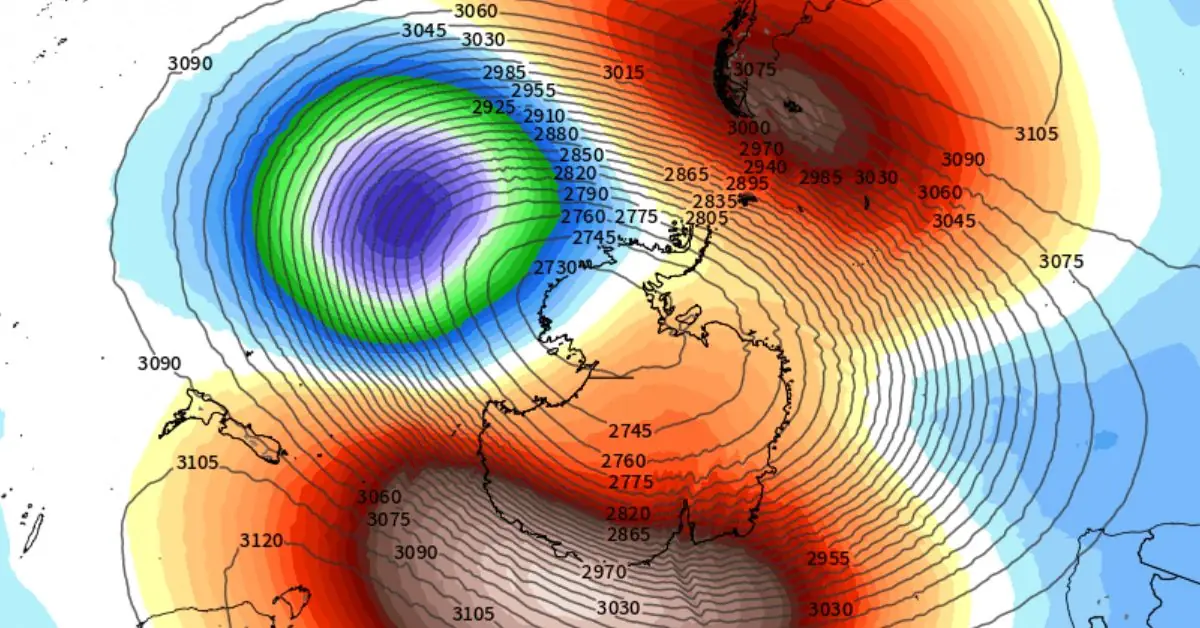Rare Sudden Stratospheric Warming event detected over Antarctica

A rare Sudden Stratospheric Warming (SSW) event has been detected in the stratosphere above the Antarctic region over the past week. Forecast models predict it will start to filter down through the atmosphere later this month.
SSW refers to an abrupt increase in air temperature high above either of Earth’s polar regions, typically on the magnitude of tens of degrees Celsius in a few days. This warming occurs in a layer of the atmosphere called the stratosphere, roughly 30 to 40 km (19 – 25 miles) above the surface.
While SSW events do not affect the weather patterns near the ground immediately, they can filter down through the atmosphere and influence tropospheric weather in the weeks after.
“If an SSW event does make its way down to the troposphere, it can cause the tropospheric polar vortex to weaken, which allows cold polar air to drift further away from Antarctica (or the Arctic if in the Northern Hemisphere) and spread towards the mid-latitudes,” said Ashleigh Madden of WeatherZone.
SSW events can cause the Southern Annular Mode (SAM) to shift into a negative phase, which could impact the Australian winter, bringing more cold fronts and low-pressure systems to southern Australia while increasing the amount of rainfall and snow in the southeastern and southwestern regions of the continent.
It would also bring stronger winds to the southern regions of the country while causing reduced rainfall in parts of Eastern Australia, according to Madden.
SSW events are rare in the Southern Hemisphere, with only a few known events in the past decades, but they can be powerful and are known to have an effect on the entire globe, said Andrej Flis of Severe Weather Europe.
“These stratospheric warming events pack a lot of energy and can affect the entire hemisphere. We have had several cases where that happened in the Northern Hemisphere, affecting the winter weather patterns,” Flis said.
The main reason is a weakened Polar Vortex, which creates a weak jet stream pattern, making an easy escape for icy cold air from the polar regions.

“It is possible that a large-scale event like Stratospheric Warming can cause a prolonged high-pressure anomaly over the South Pole. With several weeks to months of time, some effects of the SSW event could perhaps manifest in the Northern Hemisphere,” Flis said.
This is because the northern and southern stratosphere are connected via Brewer-Dobson circulation.
Flis pointed to a study that investigated a significant stratospheric warming event in 2019 over the South Pole. The study identified an ionospheric anomaly over the United States following this SSW, with electron charge anomalies of 40-80% observed in the ionosphere. In contrast, Europe experienced a reversed change, as the energy wave from the warming event had already reached the Northern Hemisphere.
The study found both positive and negative disturbances in the thermospheric Oxygen/Nitrogen ratio and Total Electron Content (TEC) over the United States and Europe.
These disturbances influence the geomagnetic activity of Earth’s atmosphere, with changes detectable and measurable.
Direct weather changes were observed following this significant event in both higher and lower atmospheres, with indications that the event affected the winter weather of 2019/20 in the Northern Hemisphere.
Update:
17:38 UTC, July 24
This week, the Southern Annular Mode (SAM), a key climate phenomenon in the Southern Hemisphere, has started shifting into its negative phase. The SAM, which describes the north-south movement of the westerly wind belt around Antarctica, plays a significant role in shaping the weather patterns across regions such as Australia, New Zealand, and parts of South America and Africa.
The negative phase of SAM brings notable changes in atmospheric conditions, including increased rainfall and cooler temperatures in southern Australia and parts of New Zealand. This shift can have wide-reaching effects on agriculture, water resources, and marine environments. Understanding and monitoring these changes are crucial for preparing and adapting to the upcoming weather impacts.
Meteorologists warn there are signs that another period of stratospheric warming could occur above Antarctica in the last week of July. If this does happen, it will increase the likelihood of more negative SAM phases in late winter and early spring.
Read more:
References:
1 Sudden stratospheric warming event underway – here’s what it means for Australian weather – WeatherZone – July 12, 2024
2 A rare Stratospheric Warming event has begun over the South Pole, with unusually strong anomalies now developing – Severe Weather Europe – July 15, 2024
3 Impact of September 2019 Antarctic Sudden Stratospheric Warming on Mid-Latitude Ionosphere and Thermosphere Over North America and Europe – Larisa P. Goncharenko et al. – AGU Geophysical Research Letters – July 2021 – https://doi.org/10.1029/2021GL094517
Featured image credit: ECMWF

Commenting rules and guidelines
We value the thoughts and opinions of our readers and welcome healthy discussions on our website. In order to maintain a respectful and positive community, we ask that all commenters follow these rules.